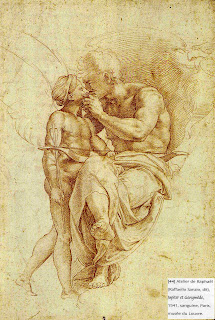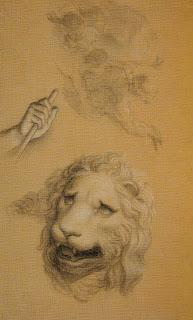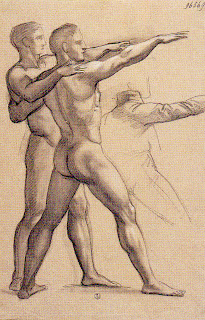POLEMIC
TOWARD THE LIBERATI NG
CRITERIA OF ART
(part1 of 2)
At 10 o’clock on any day of the week except legal
holidays, the typical art museum anywhere in the country is open for visitors.
The entrance hall usually leads the average aficionado of art through a series of
galleries in orderly progression from one imposing collection to another,
presenting the visual history of civilization, the drama of the human mind. As
far back as man could reason, his works are there: evidence of the Neolithic,
the dawn of civilizations, the antique remains of dynastic power, the classical
traditions, the intervening lines of humanist development, the Renaissance and
Baroque flowering, to the most recent acquisitions of modern and contemporary
art; they are all there, more or less, in periodic array.
As he progresses leisurely through
the halls, the visitor is led through a process of transitions in the ages of
man. He is hardly aware of the changes, yet their impact, gradual and moving,
is not lost on him. He correlates the concrete visions of the past into a
stirring processional of events.
As he reaches the modern age, his
eye is delighted with the radiance, the luminosity and joy of impressionism.
Yet he is vaguely disturbed by its unmannerly sketchy appearance, its random
spontaneity, its lack of finish, its seeming amateurishness.
Then, as he crosses the threshold to
the new art, to postimpressionism and beyond, deep into cubism, expressionism,
abstraction, and surrealism-their derivations and deviations the alarm bells
begin to ring in his head, the sirens and the fireworks go off, and our
aficionado of art-who is not a snob, by the way- is left in a morass of
helpless confusion and dismay. The even tenor of his mood is disrupted in the
colorific visual violence, the aesthetic assault from the walls. The simple
progression is gone; the contact with life is demolished in a pyrotechnic
profusion of unrecognizable fulminations.
In the art of the past, there seemed
to be no line of visual expression our visitor to the museum could not follow.
No matter how far back, even to Palaeolithic cave art, he could trace the
thread, the primitive urge, the historic need, the humankind. At times, the
line stretched thin and tenuous; at others, strong and firm. But always it was
there for him to see, a long unbroken line of human succession, linking a vast
reach of time, twenty thousand years of change. Now in his own time, in the day
when the visitor and modern man have arrived at a new age of invention and discovery,
recognizing the demand of every human need and the promised fulfilment of every
human dream, the historic line of art communication in human understanding,
imperative now more than ever before, has broken down. The new art that
thundered down at our receptive visitor to the museum is filled with an
eclectic diversity of forms-biomorphic, kinemorphic, psychomorphic, mechanomorphic-all
of them intensely personal, subjective expressions of inner states of being.
The figure in art, the highest expression of man's visual creative powers, the
subject of twenty thousand years of painstaking search, has been reduced to a
number, a cipher, an esoteric symbol, a kinesthetic impulse driven by a
primitive-emotional urge. Today, the anatomical man, for all artistic purposes,
is dead.
Art, in the mid-twentieth century,
is in a period of critical transition. We are seeing today an extraordinary
concentration of effort and energy in the visual arts never before experienced
at any time in history. Never has there been so widespread an interest, never have
so many individuals participated actively in its creation. Never have we had so
much contact with art of all kinds-art from the dim reaches of time, art from across
the oceans, art of primitive peoples; art from the past great eras to the
modern era; fine art, commercial art, industrial art, technical art,
experimental art, psychological art, leisure art, amateur art. It would appear
we are seeing a great new Renaissance in visual art, for in the volume of art
creation we are witnessing a cultural phenomenon of the first magnitude.
In the frontiers of knowledge and
culture, art may be said to be in its heyday of exploration. The exploratory fervour
of the sixteenth century, using new logic, new mathematics, new science, opened
the unknown areas of the world to commerce and physical contact of peoples and
brought out a treasure of artworks to the Western world, which only now, in the
twentieth century, is being experienced by artists in our time. Like the riches
of the East in an earlier day, this influx of art is beginning to be seen,
felt, and assimilated. The day of global exploration is accomplished. Now has
begun the day of cultural exploration, some five hundred years later. Yet never
has there been so much confusion in the arts as there is today.
The twentieth-century artist appears
to be in a state of conflict and disorder. He has a world of art to explore,
yet he shows no purpose, no goals. He seems to have lost his sense of direction
as he ranges across the uncharted art frontiers. He has rejected the compass; he
has thrust aside standards, criteria, definitions; he has renounced science as
a tool in the discovery and development of art. He has rejected the human need
to relate, to communicate the results of discovery.
If we recognize it is the mission of
science to define with clarity and precision the workings of the universe, to
relate with order and harmony the new concepts of time, space, and energy into
new and better ways of life, we reach the conclusion that science is the most
powerful instrumentality in the progress of man. To the artist, however,
science is considered an invasion, a hindrance, a stricture upon his free and
personal interpretation of the world. He sees the scientist as an intellectual
instrument-precise, logical, mathematical, mechanical. He sees himself as a
sensitive organ of feeling, emotion, inspiration, and intuition. As a result,
the artist rejects science and scientific thinking in the projection of art.
Art to be pure, he reasons, must be devoid of science; feeling is not precise; emotion
is not mechanical; inspiration is not logical; intuition is not measurable-the artist
is no scientist. Attempting to distinguish the work of art from other works of
life as a refinement of cultural endeavour, distinct and separate from the
ordinary and commonplace necessities, the artist has in effect said that
science prods and pushes with the workaday things to build a better mousetrap,
while he, the emotionally endowed aesthete, represents the inspiration at work,
the filtered aesthetic reflex of society, the fine arts. It is a neat trick of
turning the tables; the bohemian wastrel and garret outcast, through
intellectual legerdemain and bootstrap levitation, has become an individual of
a pure kind. In this state, he raises above plebeian strivings to a position of
sophisticated recognition and social grandeur, and from this remote pinnacle
surveys the marketplace mediocrity below.
How devastating and destructive a
view this is can be gauged by the fact that in every other area of modern life,
in every field of endeavour, science merges easily, compatibly,
productively-except in the visual arts. Only here is the view held- by artists
of all idioms, indeed, the whole of contemporary society-that science and art
do not mix, that they are mutually contradictious, irreconcilable. Yet this is a
distortion of the truth, a delusion, a self-imposed deception, a retreat from
life.
The dislocation of art and science
has never been so apparent as it is today, almost a hundred years from the time
it first revealed a disturbance in the continuity of art communication. The
impressionist rebellion, the last flower of the humanist spirit of the Renaissance,
still exhibiting its attachment to scientific precepts in its spectral light
and its recorded observations of the momentary life of the people, their work,
recreation, and leisure, was too weak a movement to triumph over the entrenched
authority of the regressive French Academy. When it withered and died after twenty
years of frustration and social exile, the deep space of the picture plane
became a barren shell; the landscape closed down into a two-dimensional
decorative pattern of shapes; the vibrant pulsating figure, the human analogue,
shrank and hardened in to an artefact, a constructed intellectual object; the
artist's emotional power and insight in human affairs subsided into symbolic
outcroppings of tenuous moments of excitation, apprehension, or despair.
In their seizure upon the
"immediate" and the "personal," the followers after the
impressionists disengaged themselves from every known principle of spatial
structure and design. They withdrew from earlier concepts of form, value, color,
and image. They worked toward the total rejection of the Academy. In their
hatred of the "academic," they extirpated the scientific legacy of
art, carefully nurtured and marshalled over fifty centuries of historic development,
and erased it in a short span of fifty years. In their need to rebel against
the "academic", they rebelled against science. They proclaimed the
distinction of the "fine arts" and gave it to society as a new
description, uniquely different from academic art or the utilitarian commercial
art. They presented to the entire contemporary generation of society and the
artists who followed the doctrine that "art" was above scientific discipline,
above definitions and criteria. The need to communicate in art, to be responsible
for the exchange of art experience in to human experience, was considered to be
an anachronistic demand of aggressive academic vulgarity, and was held beneath
contempt.
The rebellion against the
"sterile", the "mechanical," the "academic"-truly
a human cry of anguish- had become a distortion and a delusion. The fine artist
had turned his back on reality. He became an incoherent high priest of good
taste, an absolute arbiter of egocentric mirror-image art, a melancholy,
involuted microcosm turned in upon itself to an inevitable dead end.
Yet the impulse to art is
unquestionably the impulse to life. The art process and the life process are an
indissoluble entity. The components of one are the components of the other.
They may be uneven, but never alien; they may be out of joint, but never out of
union.
The need to create, to synthesize
experience, is a primal force in art. Because it is the distilled essence of
perception and experience, art needs its adherence to life. But the work of art
of today needs, more than ever before, the energizing transfusion of commonly shared
experiences. It needs a conscious agreement with the cross-fertilizing, wider empirical
objective.
Artists of today stand at the
crossroads of immense opportunities and possibilities.
What they have discarded earlier in
the scientific discipline of art as academic, inhibitory, and repressive of
free expression they now substitute, strangely, with new science! In their
search for a new basis of art without restraints, they lay hold on the world's
storehouse of art, which they now have a t their command. They feel the impact of
new scientific fields and attempt to resolve these in visual terms. Virtually
the entire gamut of human and social discovery, scientific and technical
advances have found their place in the free interplay of the design structure.
Never in the entire history of art have so many variations of art expression
occurred in a single given era. The range of concepts and movements is truly enormous;
even as this is being written, new ones are being born. The listing of a few at
random is to indicate the multiplicity of reactions to the technical-scientific-analytical
age.
Thus, starling with impressionism,
we have: pointillism, neoimpressionism, postimpressionism, fauvism, cubism
(analytical and synthetic), expressionism (three schools, perhaps more), Orphism,
surrealism, abstraction, Dadaism, futurism, nonobjectivism, neoplasticism, constructivism
, purism, Bauhaus, primitivism, social realism,
dynamism, abstract expressionism,
abstract surrealism, mobiles, stabiles- and on and
on, et cetera.
The list seems endless. In these
definitions can be seen some of the descriptive leads to the larger environment
of the age, where the art form has attempted to embrace psychology and
psychoanalysis, natural history, biology, chemistry, physics, kinetics,
mechanics, engineering, archaeology, anthropology, microscopy, telescopy, etc.
In the fission and fusion of two-dimensional space, the artist uses science
pragmatically, experientially, without whole concepts. Nevertheless, it forms
the basis of his art. But it is not a complete art. For, in the practice of it,
the artist simultaneously rejects the existence and influence of any scientific
rigor, control, criterion, or standard. His art, perforce, without objective
direction, releases a welter of exquisitely personal, eclectic minutiae.
If we quickly scan the art horizon
and examine the amazing output of art today, we find endless experiments in
textures; inconclusive shapes, masses, forms; positive and negative space;
tensions of line and mass; contrasts in color; line variations; eclectic
working together of art old and new; cell structure; automatic writing-endless,
precious, purist variations, powerless to come to grips with itself, to
proclaim any direction or value judgement for others. The figure in art-always
the touchstone of the art of any era-has become the visual admission of the
artist's failure to cope with the ethical-moral, social-human needs of our
time. It is a symbol of dislocation and depersonalization; the ideograph of the
alienated man, insecure, lonely, without fiber; the portrait of the artist, the
autograph of the author.
Probably the most disturbing
phenomenon in the art of the current century, a result of the dislocation in
the dualism of art and science, is the profoundly pervasive indifference of the
whole contemporary generation of artists to formulate a clear-cut definition of
art itself. The obscurantism, the evasive arguments and denials, the lack of
any direct, forthright statement, is evidence of a deep-going crisis in art. With
the exception of a few scholars, nowhere in the field of art has there appeared
a challenging assertion to say what art is in our time.
In the social arena of modern living,
the most engaging diversion is the extensive practice of generalized and
personal analysis. Because we live in a technical scientific-analytical age of
calculating machines and statistical truths, we respond to the powerful
pressures of analytical behaviour-to define, to clarify, to identify. It is a
great game of analysis; dissection and decortication of the underlying
mechanisms in every segment of the social structure, from psychoanalys is to
social surgery. We practice the analytical game everywhere except in the fine
arts. Here, in the arts, the emotional fog rolls in , intellectual inertia
overtakes us, and the cultural swamp remains undefined, unexplored.
Words like style and taste have no
clear meaning except, perhaps, in commercial usage. And the special caste
terminology- feeling, intuition, inspiration, perception, creativity--are
ritualistic ceremonial expressions of artists, undefiled by simple definitions except
in the laboratories of clinical psychologists.































































